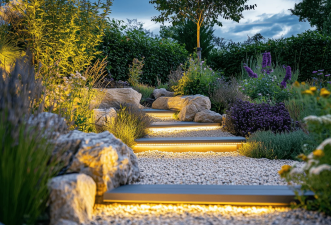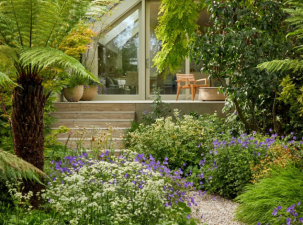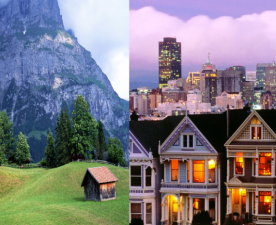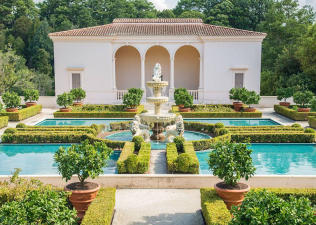Garden Design Trends Everyone Loves in 2025
With the acceleration of global urbanization and the increasing demand for the natural environment, garden design is undergoing a profound transformation, from simple landscaping to multi-dimensional functional integration. Garden design in 2025 will not only be a fusion of nature and art, but also a comprehensive solution for the coordinated development of technology, ecology, society, and humanity.
Whether you have a sprawling garden or a compact balcony, innovative trends, from low-investment vegetable gardens to smart garden technology, wild meadows, and sustainable design, are truly extending the potential of your outdoor space. Planting pollinating flowers, creating portable gardens, or dryland landscapes embraces nature while reducing maintenance.

Style Trends:
Finding a Balance Between Tradition and Modernity
- Modern minimalism remains mainstream, with clean geometric lines paired with materials like exposed concrete and metal gratings to create a sense of transparency. Sunken wooden platforms in corners, paired with clean-lined outdoor sofas, create spaces that are both suitable for daily solitude and easily accommodate small gatherings with friends.
- New Chinese aesthetics continue to gain popularity, not overly pursuing retro symbols but reinterpreting traditional artistic concepts with modern techniques. For example, consider using a mosaic of dark tiles, paired with a bamboo and gravel landscape, or placing a cantilevered preservative-wood tea table against a white wall. These techniques incorporate the art of "changing scenery with every step" into every detail.
- A trend toward naturalistic charm is quietly gaining momentum. Forgoing overly manicured hedges, perennial herbaceous plants like sage and pennisetum are used to create flower borders, complemented by irregular stone stepping stones. This creates a natural atmosphere that feels "man-made yet natural," making it particularly suitable for families who prefer a low-maintenance garden.
Functional Layout:
Making Every Corner Serves Your Lifestyle
- The courtyard is no longer simply a viewing space; it's an "outdoor living room" that extends indoor living.Combined leisure areas are recommended to incorporate both shade and storage. For example, electric shades under pergolas and rattan sofas with storage provide both rainy day seating and daily storage. If space permits, a small outdoor fireplace or barbecue island can be built in, creating unique settings for autumn and winter gatherings and summer barbecues. The parent-child interaction area prioritizes safety and growth. The sandpit's edges are enclosed in curved, preservative wood, and the swings are height-adjustable. Non-toxic edible plants like blueberries and mint are planted around the area, allowing children to connect with nature while playing.
- The planting area is divided into two modules: "Ornamental" and "Practical." The area near the living room is planted with ornamental plants like roses and clematis in flower boxes. The backyard features terraced vegetable plots planted with easy-to-care-for fruits and vegetables like tomatoes and strawberries, creating a beautiful environment and allowing for the enjoyment of picking.

Plant Pairing:
Returning to Ecology, Incorporating Seasonal Beauty
- Prioritizing Native Plants: Selecting species adapted to the local climate reduces irrigation and pest management costs while providing a habitat for birds and butterflies. - Create a "timescape": By playing with flowering seasons, leaf colors, and fruity aromas, the courtyard changes its appearance with the seasons—spring cherry blossoms drift down the stone paths, summer jasmine fragrance fills the pavilion, autumn red maples and golden osmanthus complement each other, and winter wintersweets are paired with evergreen pines and bamboo, achieving "a unique landscape for each season."
- Multi-sensory design: Plant aromatic plants like rosemary and mint along the path, allowing visitors to gently touch the leaves as they pass by to release their fragrance. Choose plants with unique leaf textures, such as the soft touch of fleabane or the rough surface of paper mulberry, to enrich the tactile experience.
Key details:
Make the design stand up to scrutiny
- Create a "small but exquisite" waterscape: Instead of pursuing a large fountain, create a cascading water feature in a corner. The sound of water hitting pebbles can drown out city noise. Alternatively, transform an old ceramic pot into a miniature fountain and pair it with aquatic plants like pennywort to create a low-cost yet dynamic water feature. - Decorative elements should be "minimal but refined": Choose pieces that complement the overall style. For example, in a modern courtyard, you can place an abstract metal sculpture, while in a Neo-Chinese courtyard, an old stone millstone can be used as the base for a tea table. Avoid overcrowding with garden ornaments and maintain visually clear space.
- Material selection should be "durable and sustainable": For outdoor flooring, preferably use malva preservative wood or imitation stone PC tiles, which are both aesthetically pleasing and wear-resistant. Fences can use openwork metal mesh to allow vines to climb naturally, reducing the sense of oppression caused by rigid partitions.


